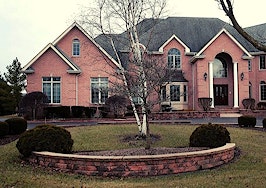Lew Sichelman is a seasoned writer with 50 years of covering the housing and mortgage markets under his belt. His biweekly Inman column publishes on Tuesdays.
Everyone in real estate knows that nothing good stems from a rash of foreclosures. But do you know exactly how “repos” impact the market?
We know that lenders lose money, and people who lose their houses cannot buy another one, at least not for a while. But according to a new working paper from the National Bureau of Economic Research, lender take-backs tend to “freeze” the market for non-foreclosures. In other words, the entire market for all houses slows or comes to a halt.
Nothing surprising there, perhaps. But the study by Boston University’s Assistant Professor of Economics Adam Guren and Timothy McQuade, an assistant professor of finance at the Stanford Graduate School of Business, also found that “policies that tend to slow down the pace of foreclosure can be counterproductive.”
Holding foreclosed properties off the market “can be effective if the cure rate is sufficiently fast,” concluded Guren and McQuade.
But if households don’t figure out how to get out of their financial difficulties quickly enough, it tends to lengthen the crisis, the authors maintain. And if that occurs, the benefits of having fewer repossessions on the market in the first place are offset.
“The effectiveness of slowing down the rate of foreclosure completions depends on the rate at which home owners cure by regaining the ability to pay the mortgage or becoming above water,” the authors write.
“If the cure rate is fast enough … slowing down foreclosures can be effective on limiting the amount of default. If the cure rate is sufficiently slow, which is likely given the (evidence), the effect of lengthening the crisis can dominate and slowing down the rate of completions can actually exacerbate the crisis.”
Gruen and McQuade also argue that other policies — government injections of equity in borrowers accounts, reductions in borrowers’ loan principals and a government program to purchase distressed houses — all work to keep foreclosures off the market and maintain balance.
Of the three, they find a government-sponsored facility “to be highly cost-effective” in that is most directly addresses the imbalance between supply and demand. And, in turn, it also helps to improve lender balance sheets, which further cuts into the severity of a foreclosure crisis.
Equity injections also are “quite effective,” they say, and principal injections are more efficient than previous studies suggest. But they “are still the least-cost effective” of the policies they studied, largely because of “imperfect targeting.”
Foreclosures were a dominant feature of the 2008 housing crisis. Between 2006 and 2013, 8 percent of the owner-occupied housing stock experienced a foreclosure. Sales of repossessed houses accounted for more than 1 in 5 existing home sales nationally for four straight years during that period, while non-foreclosure sales dipped 65 percent. And of course, prices dropped precipitously.
Prices indices at the time plunged by a third, with prices for non-distressed sales dipping by about 25 percemt. At the same time, more previous owners than ever had a repossession in their credit records.
Gruen and McQuade find that the combined impact of buyer “choosiness” because of the sheer number of foreclosures on the market at any one time and the large number of could-be buyers with a foreclosure-pocked credit history accounted for 25 percent of the total decline in non-distressed prices and a third of the decline in prices overall.
They calculate that the reduction in lending by lenders who pulled in their horns so as not to incur further losses accounted for nearly 23 percent more of the price decline in non-distressed sales and 27 percent overall.
That leaves 40-52 percent of the decline attributable to a permanent shock resulting from the bursting housing bubble.
“These amplification effects are far more substantial than those found by micro-economic studies of foreclosures,” the authors report. “Such studies compare the highly local effect of foreclosures on neighboring prices and find minor effects. We find more substantial effects because our structured approach allows us to analyze market-wide equilibrium effects that are absorbed into the constant in micro-studies.”
Meanwhile, a study from Lending Tree finds just 600,000 houses were in the foreclosure process last year as compared to about 2.9 million in 2010, the height of the housing bust. And after polling lenders on its site about how long a foreclosure remains on people’s credit reports, they matching service has even better news.
While a foreclosure remains on records for at least seven years, credit scores and loan terms start to improve well before those seven years as the foreclosure recedes into the background and is superseded by more recent information.
Here a few other key takeaways from the LendingTree study:
- Credit scores can decline by 150 points or more with foreclosure, but many borrowers still maintain a high score, even after such a calamitous event. Seven percent of borrowers end the year of foreclosure with a score above 680, while 2 percent finish with one above 740. The latter category is considered super-prime borrowers. Credit scores increase by about 10 points for each year after foreclosure. (Here’s a backgrounder on credit scores, if you need a refresher.) “If your credit score is 700, for example, you’re considered to have ‘good credit,'” explains Bankrate.com. “This means you’re unlikely to fall behind on your credit card payments or take out a loan you can’t repay. If your credit score is 400, you’re considered to have ‘poor credit.'”
- More than 30 percent of those with a foreclosure in their file have a credit score of 640 or higher within a year of the foreclosure. That number rises to 46 percent after three years.
- Borrowers are able to quickly re-enter the market after foreclosure — in as little as two years. However, they pay a premium to do so. In LendingTree’s sample, borrowers with a credit score above 740 paid an average rate of 5.02 percent, compared with 4.7 percent for borrowers who have never had or did not reflect a foreclosure in the previous seven years.
- And finally, there’s this from Auction.com: 56 percent of properties sold to third parties at foreclosure auction were owner-occupied one year after the auction date, compared to 43 percent of properties that reverted to the foreclosing lender. Also, properties sold via a “Day 1” Real Estate Owned (REO) online auction sold on average 95 days faster than REOs sold though local multiple listing services. The company’s Q2 2019 Seller Strategy report analyzed disposition strategies employed over the past year for more than 23,000 properties that went to foreclosure auction through its platform, which accounts for nearly 50 percent of all properties sold at foreclosure auction nationwide.
Lew Sichelman is a seasoned writer with 50 years of covering the housing and mortgage markets under his belt. His biweekly Inman column publishes on Tuesdays.













